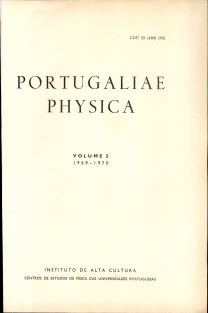
RESUME — On utilise une méthode élémentaire pour montrer que l’invariance relativiste des pressions, en général admise, n'est valable que dans les problémes adiabatiques (flux de chaleur nul). On présente les formules générales de transformation des tensions, dans les cas adiabatique et non adiabatique, et on développe, dans une bonne concordance avec ces formules, un formalisme invariant de la mécanique non adiabatique des milieux continus, généralisation du formalisme adiabatique usuellement présenté.
ABSTRACT — Corrections to RPA transition amplitudes arising from ground state correlations due to the zero point motion of the several degrees of freedom have been considered elsewhere. Since a complet set of states was required in the derivations the zero point motion of the spurious degrees of freedom was also involved in the expressions obtained for transition amplitudes. It is shown here that the contribution of the spurious states actually cancels out in those expressions if the transition operator commutes with colective operators such as center of mass position and total momentum.
SUMMARY — The convergence and the concentration dependence of the iso- topic thermal diffusion factor is theoretically studied, on the basis of Lennard-Jones and exponential-six models. The concentration dependence is not negligible a priori for binary mixtures of light isotopes, and significant differences may be expected for ay if one or other of the isotopes is present in tracer concentrations. In the majority of practical cases, the Kihara-Mason scheme of approximation provides better convergence and is therefore preferred.
SUMMARY — Experimental data for mixtures of 3He — 4He and H2 — D2 have been interpreted by means of the isotopic approach for the thermal diffusion factor, including a concentration-dependent term. It is shown that for 3He — 4He mixtures the approach is quite satisfactory, regarding the mass effect and the concentration dependence. For H2 — D2 mixtures the mass coefficient (m1—m2)/(m1-+-m2) is already too large and general expressions for ατ might be preferred.
ABSTRACT — An attempt has been made to describe the correlation structure of the electron gas in terms of the collective modes only. A very simple formalism is obtained which leads to very good agreement with the results of Noziéres-Pines and Hubbard for low momentum transfer (k/kf <1), if one neglects the exchange terms.
ABSTRACT —Atheoretical approach of heavy ion transfer reactions is given using Glauber approximation.
RESUME — On donne une formulation des réactions de transfert entre ions lourds en partant de l'approximation de Glauber.
he electron gas in terms of the collective modes only. A very simple formalism is obtained which leads to very good agreement with the results of Noziéres-Pines and Hubbard for low momentum transfer (K/KF <1), if one neglects the exchange terms.
ABSTRACT —QA discrepancy between the formula for the correlation energy of a many-fermion system derived by the conventional random phase approximation (RPA) method and the corresponding expression derived by summation of perturbation theory bubble diagrams is investigated.
ABSTRACT — Neglecting second order terms on the dependence of the phenomenological coefficients on the local intensive parameters, a generalization of Prigogine’s theorem of minimum entropy production is presented, assuming local validity of Onsager’s reciprocical relations.
SOMMAIRE — On indique d’abord les diverses définitions possibles de Vobjet «résonance», et les critéres qui permettent d’en identifier une. — On rappelle la classification par SU3 des particules et résonances. Un prolongement de cette classification est la description a l’aide d’un modéle de «quarks» non Relativiste, qui s’accorde avec SU6.

